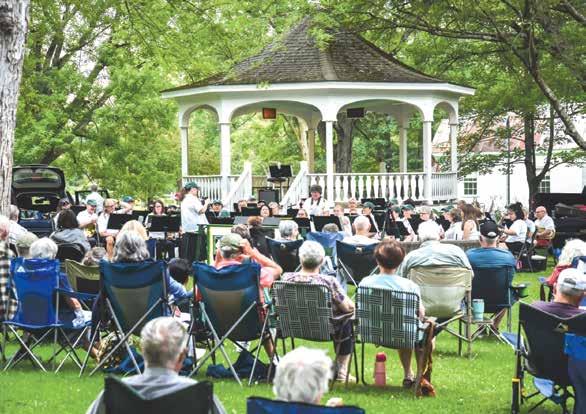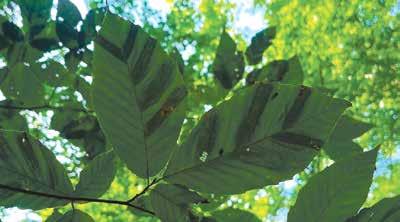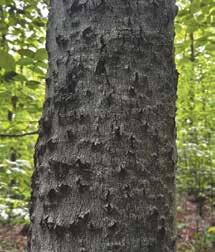

Improving your Oak Hill Road ride
Oak Hill Road needs a little love.
A main commuter route from Hinesburg and points south, the road would benefit from safety improvements for drivers, cyclists and pedestrians, according to the Williston Comprehensive Town Plan.
The Chittenden County Regional Planning Commission recently completed a road safety analysis of Oak Hill from its start in Williston Village to its intersection with Butternut Road, including the angled intersection at Old Creamery Road. A review of the study is on the Williston Planning Commission’s Aug. 19 meeting agenda.

The study collected vehicle speed and crash data, showing that most vehicles are exceeding the posted speed limit. The road has speed limit sections of 35 mph, 40 mph and 45 mph. Crash reports dating back to 2019 show that there were 14 crashes on Oak Hill Road in the past five years, plus five crashes at the four-way intersection in the Village where the road meets Route 2.
None of the crashes involved pedestrians or cyclists.
Still, the study suggests lowcost measures to calm traffic speeds, increase sightlines and improve safety for cyclists and pedestrians: Trim vegetation at the
intersections of Old Creamery, Patridge Hill and Butternut roads to improve sight distances.
Relocate 35 mph speed limit signs at the intersection with South Road to align them for both northbound and southbound traffic.
Intsall “Bicycle Allowed Use of Full Lane” and “4 foot clearance to pass” cyclists signs.
Increase speed limit enforcement and install speed feedback signs.
After implementing these measures, the study recommends monitoring road conditions before considering higher-cost measures, such as widening road shoulders and installing speed bumps.
Jason Starr
DRB considers new recycling center plan
Conservation Commission recommends site reconfiguration
BY JASON STARR Observer staff
The Chittenden Solid Waste District will be back in front of the Williston Development Review Board later this month seeking approval to construct a new recycling center on Redmond Road.
Chittenden County voters passed a $22 million bond for the project in 2022 to replace the existing recycling hub on Avenue C. Managed for the district by Casella Waste Systems, the recycling center processes recyclables from throughout Chittenden County and beyond.
The district (CSWD) has abandoned its original application to build the center further south on Redmond Road. That plan was approved by the Development Review Board (DRB) last year, but the land was later deemed unbuildable due to the presence of previously undetected wetlands.
The new site is at the end of the road, near the Winooski River and CSWD’s existing trash drop-off center. According to a habitat assessment commissioned by the Town of Williston’s Planning Department and completed in July, the site is free of functional wetlands, but it is a significant wildlife corridor.
“The proposed development
site was formerly open farmland dating back to at least 1906 and hosted a late-19th century or early 20th century homestead,” the application states. “It was abandoned to forest succession between 1944 and 1950.”
The application shows a 68,000-square-foot building nearly 40 feet tall built on an 8-acre portion of the overall 38acre parcel. The DRB gave the plan preliminary approval in May, and a hearing on final approval is set for Aug. 26.
The preliminary DRB approval came on condition that a wildlife habitat analysis be completed. Submitted by Arrowwood Environmental of Huntington, the report recommends the district reconfigure the layout of the site to retain as much wildlife corridor as possible. The Williston Conservation Commission echoed that recommendation.
The parcel lies within “one of the largest habitat areas entirely within Williston’s boundaries and is a critical connection to the Winooski River corridor and north into Essex,” the assessment states. “The parcel certainly plays a valuable role in maintaining biological diversity and providing multiple avenues of travel between the large, forested landscapes in all directions.”
see RECYCLING page 8

An appreciative crowd enjoys the music of the Williston Town Band last Wednesday. OBSERVER PHOTO BY AL FREY
Around

Town
Applications open for housing grants
The Williston Housing Committee is accepting applications for two programs that help low-income residents remain in their homes.
The Housing Retention Program aim is to assist families at risk of eviction. It provides one-time grants to pay up to two month’s rent or mortgage payments.
The Housing Improvement Program provides funding for home repairs or improvements, such as accessibility modifications and replacement of building components and systems in danger of failing.
Application forms are online at bit.ly/williston-housingtrustfund.
Fundraising walk set for Saturday
The inaugural Bellcate Step Club
3K Walk will take place from 11 a.m. to 1 p.m. at Village Community Park in Williston on Saturday. This fundraiser for sarcoidosis research is organized by the Bellcate school, a special education school in Essex for students ages 12 to 22.
Event t-shirts and free pizza will be available to participants.
The event grew out of the Bellcate Step Club, a group at the school that organizes twice-weekly walks for students and staff.
Kickoff party planned for Making Strides Against Breast Cancer walk
Making Strides Against Breast Cancer of Northern Vermont is holding a kickoff party Aug. 21 for its Oct. 5 annual fundraising walk, 6:30-8:30 p.m. at Back Nine Indoor Golf in South Burlington. Learn how to create a team, join a team, become a sponsor, donate or volunteer for the walk. A golf simulator, snacks and a cash bar will be available. Wear something pink and be eligible for a door prize.
RSVP by Aug. 15 to northernvtstrides@cancer.org or (802) 448-9793.
Kids’ Day at the Richmond Farmers Market


The Richmond Farmers Market will host its second annual Kids’ Day Friday, Aug. 15 with musicians, crafts and games. The market is held every Friday from 3-6:30 p.m. at the Volunteers Green.
Attractions include a giant bubble-making station, music and
Summer Blooms
at Vermont’s Finest Plant Nursery





storytelling of the Swing Peepers, lawn games, a Lego printing press, a farm-to-kid scavenger hunt, a mini golf course, a grain mill demo, temporary tattoos and more.
Shoppers will also find local produce, meat and fish, dairy, prepared food, baked goods and artisanal crafts.
“We are in peak produce season, and our dedicated farmers and talented creators have so much to offer at this time of year,” said Market Manager Marissa Green. For information, visit https://richmond-farmers-market. square.site
























Stoni Tomson of New Traditions Farm, above, is one of several farmers who sell produce at the Richmond Farmers Market.
Kristie Armstrong, right, is the Crazy Cotton Candy Lady, providing treats at the Richmond Farmers Market.
OBSERVER COURTESY PHOTOS








UVM researchers track a new forest pathogen
BY KRISTEN MUNSON Special to the Observer
Near the bottom of a shady hillside in Jericho, a lone beech tree stretches high into the canopy, a relic of a bygone forest.
Through luck or (hopefully) genetics, this mighty tree has avoided contracting beech bark disease — a fatal fungal pathogen that has proven deadly to mature beech trees. And it stands just outside a hotspot where a new pathogen called beech leaf disease is spreading across Vermont forests.
Beech leaf disease (BLD) first emerged in the United States in Ohio about a decade ago, likely by way of infected nursery stock from Asia, and has steadily expanded across eastern forests. Five counties in Vermont have confirmed outbreaks, with UVM’s Jericho Research Forest as its northernmost point. That is why one morning in late June, UVM professor and research forest manager Jess Wikle and two UVM forestry interns met with scientists from Vermont’s Department of Forests, Parks & Recreation to
map new infections.
“We don’t know how beech leaf disease is spreading,” explained Savannah Ferreira, a forest pathologist for the state. “The leading hypothesis is that it’s wind — which is not good.”
Last spring, Wikle was doing trail maintenance in the Jericho Research Forest when she reached for a branch and saw dark striping on a leaf — the telltale first sign of beech leaf disease.
“When you see it it’s a very distinctive symptom,” she said.
The disease is caused by a microscopic nematode that destroys the mesophyll layer in leaves where photosynthesis occurs. It becomes a chronic condition that deforms the leaf structure, gradually starving trees to death.
“When it showed up on the research forest I was like ‘This is terrible!’” Wikle said. “But also, if it could be anywhere, at least it’s here and we can study it.”
She and a team of UVM students mapped the extent of the outbreak last fall with state and federal foresters, including Cameron McIntire, a

Some beech trees, like this one in Jericho Research Forest, have shown signs of immunity from beech bark disease for decades. The hope is that some trees will also demonstrate natural resistance to beech leaf disease. OBSERVER COURTESY PHOTO
plant pathologist with the U.S. Forest Service in New Hampshire. He collected leaf litter and soil samples to measure the rate of infection spread
over time and to determine if the nematode is present in soils before visual symptoms occur in trees.
The Forest Service has monitored the progression of beech leaf disease for years and funds research projects to identify potential treatment and control methods for trees in landscaped and forested settings. While some interventions have shown promise, such as fertilizer applications and injections, these are not scalable for forest stands — at least not yet. But despite an uncertain prognosis, McIntire is not giving up on beech trees.
“It appears that American beech has very little natural resistance to BLD, and human intervention may be necessary to ensure healthy forests into the future,” he said.
MAPPING THE SPREAD
The untrained eye can easily miss detecting beech leaf disease. Sometimes only a single leaf on a branch will show banding. But pruning trees is not necessarily a viable management option.
“The nematodes are not visible to the human eye,” Wikle said. “So just because you don’t see it doesn’t
mean they aren’t there.”
She worries the disease will be problematic in places such as northern Vermont where beech is the only masting tree that produce large quantities of nuts for species like bear, deer and turkey across northern New England.
“So many trees have succumbed to forest pests. I wish I could have seen these forests 100 years ago,” Wikle said.
Finding trees that show resistance to emerging biological threats is key to their survival.
Humans have transformed American forests for centuries as both Indigenous populations and early settlers shaped the landscape depending on their needs. Sometimes, our actions had unintended effects. In the early 1900s, an invasive blight disappeared most of the American chestnut from eastern forests. Global trade accelerated the pace of change as new invasive pests and pathogens have reduced the presence of elms and hemlocks. Once invasive species are released in new environments, they can be see BLD page 5






BLD
from page 4
nearly impossible to stop.
In the late 1800s, beech bark disease arrived in Nova Scotia and slowly expanded throughout Northeast forests. By the 1960s it was prevalent in Vermont. The disease is caused by infestations of a tiny scale insect that introduces a fungal infection to the vascular tissue of the tree. The once smooth beech bark gains a pock-marked appearance. While the disease progresses slowly, estimates suggest between 50 and 90 percent of mature beech eventually die from it.
MANAGING INFECTED FORESTS
People notice when wildfire wipes out a forest. But beech trees can live for years after becoming infected with beech leaf disease. This lag time can reduce the sense of urgency to the problem, explained Tony D’Amato, professor of forestry in the UVM Rubenstein School of Environment and Natural Resources and director of the forestry program.
But this slow-moving killer also buys scientists a chance to learn about it and develop management plans. For instance, should we plant additional varieties of masting trees to support wildlife? Do we wait for beech survivors that have natural resistance to emerge? Do we double efforts to find treatments?
D’Amato studies adaptation strategies for forests in a time of rapid change because many forests are warming significantly faster than trees can naturally expand their range through seed dispersal. D’Amato’s projects involve testing assisted migration efforts such as planting species just beyond their historic range or to new sites within their existing range to study how they fare as the world warms.
We often look at trying to create

Beech bark disease spread from Nova Scotia to forests across the Northeast in the late 1800s. The disease is caused by infestations of a tiny scale insect that introduces a fungal infection to the vascular tissue, leading to a pockmarked appearance of the bark, right.
Beech leaf disease, above, by contrast, is a newcomer to the Northeast.
OBSERVER COURTESY PHOTOS
























Preserve local school boards; preserve local democracy
BY LAURA CANNON
We won’t always agree with every decision our school boards make, but we should all agree on this: They must exist. Without them, we lose local democracy, community involvement and taxpayer oversight. Vermont communities value taking local responsibility for education, community-based schooling, and school board representation. We care deeply about where and how our kids learn, and we want a say in it.

Community Newspaper Since 1985
www.willistonobserver.com P.O. Box 1401, Williston, VT 05495 | 802-489-5499
ADVERTISING
Rick Cote, Associate Publisher rick@willistonobserver.com 802-373-2136
EDITOR
Jason Starr editor@willistonobserver.com
PRODUCTION & DESIGN
Jan Kenney
jan@willistonobserver.com
PUBLISHER
Susan T. Cote susan@willistonobserver.com
BILLING INQUIRIES
Michael McCaffrey office@willistonobserver.com
Member:
ADVERTISING SPACE DEADLINE
Friday at 5 p.m. for the next Thursday issue rick@willistonobserver.com, 802-373-2136
CLASSIFIED ADS
Deadline is Friday 5 p.m. There is a fee for business, real estate, help wanted and legal ads. Free classifieds must be 25 words or fewer and are printed on a space available basis.
SUBMISSIONS & LETTERS
Deadline is Monday noon for Thursday issue. News/ story tips are welcomed. Letters to the Editor should be 300 words or fewer and include your name, address and a daytime phone number so that we can verify the letter’s author.
The Williston Observer reserves the right to edit or refuse submissions or advertising. Opinions expressed in the paper are those of the writer and do not necessarily reflect the opinion of the paper.
publication of Twin Ponds Publishing LLC

The Rural Schools Community Alliance — a coalition of community and municipal groups, school boards and educators — has fought hard to preserve these values in the recent legislation. Thanks to our efforts, the new law, Act 73, recognizes Supervisory Unions in addition to Supervisory Districts — giving rural voices a chance to be heard.
If existing school districts are eliminated and replaced by a large Supervisory District — as favored by the governor and Agency of Education — our local school boards would vanish. Existing articles of agreement would be dissolved. Decision-making power would shift to a distant, centralized board overseeing 4,000 to 8,000 students. Town-level representation would disappear. Budget decisions and school closures would happen without a vote of the town.
Under a Supervisory Union structure, by contrast, existing school boards would continue as would existing articles of agreement. Although this may entail boundary shifts and much larger Supervisory Unions than we are used to, we would keep a seat at the
table. We would continue to have a meaningful voice in decisions made.
Budget decisions and school closures would happen without a
vote of the town.
We would keep our say. Some advocacy groups argue that Supervisory Unions open the door to privatization. That’s a distraction. The real threat is centralized power in sprawling districts, where communities lose influence. Supervisory Unions allow for shared efficiencies, collaboration and cost-effective shared services, without silencing community voices. That’s the balance Vermont needs.
Act 73 established a redistricting committee that has been appointed and is already beginning its work, with up to three proposals due in December and a vote by the Legislature to approve one in January. We must act now to influence the outcome. We are not
powerless, and there are knowledgeable members on this committee who understand rural concerns. Talk to your school board. Call your legislators. Let them know: We want to stay in a Supervisory Union. We value local decision-making.
Much of Vermont is rural. Our education system should reflect that and be accessible for rural families. Without community based schooling, transportation challenges and long bus rides may force young families like mine to leave Vermont’s small towns at a faster rate than they already are, further accelerating small town economic decline. Consolidation of school governance means disappearing civic engagement and a diminished ability to influence important decisions about education in the future. That’s what we risk if we let our school boards go.
This is a fight for more than education. It’s a fight for our communities. It’s a fight for democracy. It’s a fight for rural Vermont.
Laura Cannon of Hardwick is a member of the Rural School Community Alliance, online at vtruralschools.org.

LETTERS TO THE EDITOR
Time to transform education
After a clear call from Vermonters for change, this past legislative session, my team and I worked with the Legislature to pass a bill that will transform our education system, stabilize property taxes and reverse the growing inequality in our current system to unlock more opportunities and better results for our kids.
The next major step in this process is establishing new districts to consolidate unnecessary administration and operate more effectively. This week, the School District Redistricting Task Force will begin that work. Having bigger districts, and fewer superintendent offices, is critical to getting more of the money we invest in education to be spent on our kids in their classrooms.
Right now, from town to town and district to district, our system is not equitable. This reform will give us an opportunity to change
that, if we stay focused on the fundamentals and follow through.
This work will be criticized by some, who continue to advocate for the status quo, despite the clear need for change. But the fact is, for the money Vermonters are spending, we’re not getting the results we should in key areas, including elementary grade reading and math, where we’re average or below average when compared to other states.
We owe it to our students to make sure kids in places like Sutton have the same educational opportunities as those in places like Shelburne — and that their teachers are also paid comparably, and most Vermonters agree.
Together, we can build the best education system in the nation, and I’m hopeful this Task Force will rise above the politics and keep moving this essential transformation forward.
Phil Scott Vermont governor

Wednesday, August 6 - Sunday, August 10
Get ready for five days of hot deals , cool discounts, and can't-miss promotions all along the Marketplace. Check out the offers and events below —save this page for your next downtown stroll or pi n it to the fridge so you don’t miss a thing!
Bertha Church Intimates
Support you can count on—bras and select sleepwear are 50% off!
Black Cap
Coffee & Bakery
Sip & win! Enter to win a $10 gift card each day with your same-day receipt. One lucky winner drawn daily.
Designers’ Circle Jewelers Bling it on! Enjoy 10%–50% off the entire store.
ECCO Clothes
Summer steals are on! Get up to 70% off!
FatFace
Get that effortless British style. Up to 50% off sale items!
Kiss the Cook 30% off Staub 5qt Dutch ovens and select Zwilling knives. A 50% off table filled with kitchen textiles and gadgets, and $2 off knife sharpening!
Rí Rá Irish Pub First 25 customers each day score a free bar swag bag. And don’t miss out - Reuben Slider Demo on Fri, 8/8 from 34:30pm. Cheers!
redundancy to maintain forest function, said D’Amato. Diverse forests are more resilient when disturbances occur, and by eastern standards, Vermont’s forests are diverse with over 30 tree species.
“We are lucky we already have a deck with more than two cards in it,” D’Amato said.
As beech leaf disease spreads, he cautioned against taking action simply to do something. This is the time “to monitor and learn as much as we can,” he said. “No tree is immune to a chain saw.”
ZOOMING
IN ON THE PROBLEM
The tiny nematode behind this giant mess remains something of a mystery. Scientists have found the nematode can survive under snowpack, and it has been found inside insects, bird droppings and spore traps. While it increasingly appears that the nematode is transported by wind and water, it may travel outside the advancing front by birds or on the bottom of a hiker’s shoe. Nick Aflitto, an assistant professor of forest health at UVM, aims to better understand this microscopic menace.
Nematodes don’t have great vision or acoustic signaling abilities, Aflitto said.
Learning how this species of nematode uses chemical signaling to find beech trees in the forest may also help stop them. Aflitto studies sensiochemical signaling such as the pheromones ants emit when they find a food source. Depending on the signature, compounds can greenlight a route or act as warning signs to danger ahead. Plants do this too.
Think of the smell of mown grass, Alflitto explained. Leaves munched by animals or insects produce a scent for other plants nearby to raise their defense systems.
“There is huge potential for using it for invasive species,” he said. “But we need to be able to detect them first.”
In the spring, Aflitto began attaching small
rubber traps soaked in chemical compounds to diseased beech trees to attract the nematode and learn more about its behavior. His lab uses artificial intelligence to predict new biocontrols that may fast track the development of control methods for emerging forest pests.
“We have been manipulating the odorscape for a long time,” Aflitto said. “It does work.”
Using chemical compounds to attract or deter invasive species carries less risk of off-target effects than using biological controls such as introducing another species to an ecosystem to eat the invasive one.
“While we are getting better at it, we’ve seen that go wrong time and time again,” Aflitto said.
HOLDING OUT HOPE
When the emerald ash borer first emerged, it was alarming because of how little scientists knew about the problem, Feirrera said. “But now we have biocontrols for it; we have chemical controls for it. We know how to manage ash in the forest. We know that there are lingering naturally resistant ash trees. I think it’s going to be kind of shocking when we get this first wave of (beech leaf disease) spreading, but I am staying hopeful that we are going to learn a lot in the next couple of years.”
There are bright spots. Vermont was the last New England state to report beech leaf disease. There may be protective factors scientists haven’t uncovered yet. And while, historically, beech is not a beloved tree for its economic benefits, beech has a high ecological value.
“They have their own network of mushrooms and wildlife that depend on them,” Feirrera said. “It does feel like a lot of doom and gloom, but there are a lot of eyes looking at this pest. I am staying hopeful.”
Kristen Munson is a senior writer with the Division of Strategic Communications at the University of Vermont.
WED, AUG 6
Star 92.9 Broadcasting 11am-1pm Imagination Station 12-2pm una passeggiata 5-8pm
Brands B Good Buy one, get one 50% off storewide! Plus: USA-made fleece, wool, and sweatshirts at 40% off, and USA-made sunglasses 20% off.
Catamount Store
Score major deals on UVM merch—tees, sweatshirts, accessories, and more at deep discounts! Get in early for best selection.
Golden Hour Gift Co. Save 20%-50% on select items and catch new daily specials. Follow along @goldenhourgiftco for the scoop!
THURS, AUG 7
Star 92.9 Broadcasting 11am-1pm
Lake Champlain Chocolates Cool down with Frozen Hot Chocolate or indulge in an Affogato—you deserve it.
Dear Lucy
It’s your shoe moment—find fab footwear at 50% off and up!
Lovermont802 Take 15% off everything (except sale items), snag a free sticker with purchases over $40, and don’t miss the sales tent. Everything inside is 50% off!
Olive Oil
Flavor your summer with 10% off six packs or grab $5 off when you buy two bottles or more. Plus—free samples while you shop!
The Optical Center See the savings! Take 10% off everything in store!
Clothing Select items up to 50% off! Hatley Find women's and kids' styles from $5-$20, plus up to 70% off inside!
Helly Hansen Up to 50% off select styles and footwear. BTV merch starting at $5!
Homeport
The more you spend, the more you save: Under $50 = 10% off $50–$99 = 15% off $100+ = 20% off Everything on the sidewalk is 40% off or more!
Ken’s Pizza and Pub Score $6 off a Large Cheese Pizza on WED of Sidewalk Sale!

Olive & Ollie Score up to 50% off!
Outdoor Gear Exchange Get adventureready with 30% off summer clothing from Outdoor Research, Prana, Kavu, and more.
Phoenix Books Book lovers rejoice! Bargain books up to 75% off their original prices.

Tradewinds Imports Jewelry & gifts up to 50% off and free henna tattoos!
Vermont Flannel Company Score big on must-have finds! Enjoy 20% to 50% off select merchandise.
Zinnia Shop with snacks and surprise giveaways! Plus, enjoy sweet sale items!

Saratoga
Recycling
continued from page 1
The assessment notes that the building footprint as designed is too close to the steep Winooski River bank to maintain an unfettered wildlife corridor and recommends a new layout that will maintain a wider buffer from the river.
“I don’t like the siting of the project,” DRB member Scott Rieley said in May before joining in on a unanimous preliminary approval vote. “You’re siting the building right in the middle of a wildlife corridor.”
Greg Dixson, representing CSWD’s design engineer, Krebs and Lansing, countered: “I think there are multiple ways animals can get around the building.”
It’s unclear whether plans submitted for final approval ahead of the Aug. 26 DRB meeting have an altered site layout.
Meanwhile, the CSWD’s board of commissioners entered into a closeddoor session at the end of its July 30 meeting “to discuss pending or probable civil litigation related to the (recycling center).”
WILLISTON POLICE
June 22 at 6:38 a.m. — Male sleeping in the vestibule at East Rise Credit Union. Male was moved along.
June 22 at 10:59 a.m. — Report of a male walking in the middle of the road, flagging down cars. Male was gone before officer’s arrival.
June 23 at 3:11 p.m. — Male in Best Buy who attempted to steal something. Male was located and issued a citation to appear in court for retail theft, unlawful trespass and violation of conditions of release.
June 23 at 5:23 p.m. — Report of a male who was unresponsive in his car on Cornerstone Drive. Male was transported to the hospital for evaluation.
June 23 at 10:31 p.m. — Male yelling at Zephyr Place. Male agreed to quiet down.
June 24 at 7:38 a.m. — Stolen credit cards used at Walmart. Female suspect was located and issued a citation to appear in court for credit card fraud.
June 24 at 2:58 p.m. — Stolen vehicle out of Colchester recovered on Van Sicklen Road.
June 24 at 5:48 p.m. — Male causing a disturbance

9:00-3:00

9:00-3:00
9:00-3:00






at Taft Corners Shopping Center. Male was issued a notice of trespass and moved along.
June 25 at 3:33 p.m. — Assisted a female with trespassing a male from her property.
June 25 at 5:49 p.m. — Assisted a business in Taft Corners Shopping Center with trespassing individuals who have stolen from the business in the past.
June 26 at 8:47 a.m. — Report of stolen credit cards being used at Walmart. Female was located and issued a citation to appear in court for credit card fraud and illegal possession of a credit card.
June 26 at 1:50 p.m. — Report of a suspicious male hanging out at Sandri. Male was located and issued a notice of trespass.
June 26 at 5:29 p.m. — Suspicious male in Plato’s Closet. Male was issued a notice of trespass and moved along.
June 27 at 5:53 a.m. — Report of a male and female arguing near Interstate Corporate Center. Both parties refused all services and moved along.
June 27 at 9:55 a.m. — Death investigation conducted. Nothing suspicious.
June 27 at 5:17 p.m. — Report of a male and female
acting suspicious behind Lenny’s. Both parties were issued a notice of trespass.
June 28 at 12:47 a.m. — Same male and female who were behind Lenny’s were behind Ramunto’s acting suspicious. They were both issued a notice of trespass.
June 28 at 6:54 a.m. — Report of a male and female in Home Depot who had previously been trespassed. Female was located and had an active arrest warrant. Female was transported to the correctional facility.
June 28 at 7:59 a.m. — Cushions reported stolen from a residence on Madison Drive. Cushions were recovered and male was issued a citation to appear in court for petit larceny.
June 28 at 6:21 p.m. — Suspicious male in Dick’s Sporting Goods. Officers attempted to stop vehicle and he fled. Male was ultimately issued a citation to appear in court for eluding a police officer, leaving the scene of an accident, violation of conditions of release and grossly negligent operation.
Officers also conducted 40 traffic stops and responded to 5 alarms activations and 12 vehicle crashes during this time frame.
10-5
11-4
Kailey's Way in Hinesburg, VT, off Route 116 behind the Parkside Cafe and Kinney Pharmacy











Recreation & Parks WILLISTON
FALL/WINTER PROGRAM GUIDE
The Fall/Winter Program Guide will be mailed to Williston homes next week. Registration for fall/winter programs will open Monday, Aug. 18.
FOOD TRUCKS
The Rec Department is compiling a list of food trucks interested in participating in events. The next event is scheduled for Saturday, Sept. 20. If you are a food truck operator who is interested in being a part of rec department events, email the department at recreation@willistonvt.org.
ADULT PROGRAMS
SENIOR COMMUNITY MEALS
Senior Meals for people aged 60plus will start up again Tuesday, Aug. 19 at the REC Zone. Pre-register at www.willistonrec.org. Check-in is at 11:30 a.m., the meal is served at noon followed by a free senior-focused program from 12:30–1:30 p.m. Cosponsored with Age Well.
PICKLEBALL 102
Ages 18-plus. A program for players familiar with the game, that will focus on refining skills such as building a point, playing with intention, court coverage and positioning, reading your opponents while simultaneously being aware of where your partner is, third shot drop, including transitioning up to “the kitchen,” and much more. Tuesday, Wednesday and Thursday, Aug. 12-14, 5:30-7:30 p.m. Instructor: Corey Gottfried
SOCCER PROGRAMS
MINIS
Soccer Minis will introduce 3-year-old children to soccer skills. You and your child will work together to develop fundamental skills such as dribbling, trapping, passing, kicking and running/agility in a fun, non-competitive atmosphere. This program does not include games. No special equipment is needed. Each participant will receive a soccer T-shirt. This is a child/parent program that meets on Saturdays in the fall.
RECKIDS
Ages 4-5. RecKids Soccer will introduce children ages 4-5 to soccer skills. You and your little one will work together to develop
fundamental soccer skills such as dribbling, passing, kicking and running/agility in a fun, non-competitive atmosphere. There are no games. No special equipment is needed. Each participant will receive a RecKids T-shirt. This is a child/parent program that meets Friday evenings from 5:20-6:10 p.m.
ROOKIES
Rookies Soccer is designed for kids kindergarten through second grade who want to learn, play and experience the game of soccer in a fun, engaging atmosphere. There are separate programs for boys and girls if numbers allow. Programs begin in September and meet on Saturdays for one hour — a halfhour clinic and a half-hour scrimmage. Volunteer coaches needed.
YOUTH SOCCER
Youth Soccer is geared toward players in grades 3-5 who want


to learn, play and experience the game of soccer in a fun and enjoyable atmosphere. There are separate programs for boys and girls if numbers allow. Teams will have the opportunity to play other town recreation department teams. Volunteer coaches are needed. Discount registration by Aug. 17; registration deadline is Aug. 24.
FREE FITNESS PROGRAMS AT THE R.E.C. ZONE
TAI CHI INTRO
Ages 50-plus. Mondays,
9:30-10:30 a.m. Instructor: Adina Panitch.
BONE BUILDERS
Ages 50-plus. Tuesdays and Thursdays, 10-11 a.m. Instructors: Ann Naumann & Joyce Oughstun.
SENIOR STRENGTH & FUNCTIONAL MOBILITY
Ages 50-plus. Wednesdays and Fridays, 10-10:45 a.m. Instructor: Jazmine Averbuck.
ZUMBA GOLD
Ages 18-plus. Thursdays, 8:459:45 a.m. Instructor: Ciara Gregory.
The Kismet Building • 373 Blair Park Road • Suite 101 • Williston


Back to School

Are you heading back to school in the next couple of weeks? It’s exciting to think about new teachers, new friends and new school supplies. For some kids, though, it’s also an anxious time.
The Mini Page checked in with a school administrator to find out how to get the year off to a good start.

Why go to school?
Sometimes the end of a fun summer makes us think, “Why do we go to school?” There are many good reasons why school is important. Can you add to our list?
• To communicate: We learn to speak, read, write, understand and be understood.
• To appreciate ourselves: We get a positive feeling of self-worth when we do well.
• To appreciate others: We study all kinds of people and cultures.
• To learn about citizenship: We will be informed, responsible community members.
• To think: We study information so we can understand it.

Mini Fact: Experts say elementary school kids need at least nine hours of sleep every night.

The first day
Most kids are nervous on the first day of school. It helps to remember that you’re not alone — it’s the first day for the other kids, too. You can make the day easier for yourself and others by:
• smiling and being positive;
• asking new kids questions about themselves and showing them around;
• having friendly body language. Look others in the eye and show interest in what they say.
Ready to learn
A good student comes to school ready to learn, but what does that mean? Good students:
• are able to listen and concentrate;
• can communicate well with the teacher and other students;
• can work well in small groups.
You can help yourself be ready to learn by:
• getting plenty of sleep;
• eating a nutritious breakfast that includes protein (eggs, meat, cheese, milk or yogurt).
First day tips
Your family may start getting ready for school days or weeks in advance. You might buy or gather school supplies and check to see which clothes you’ve outgrown.
• The day or night before school starts, assemble your supplies. Organize your backpack and make sure it’s not too heavy to carry.

(Remember, always carry it strapped to both shoulders so you don’t hurt your back.)
• Lay out clothes to put on in the morning. You might want to choose a favorite outfit or accessory for the first day.
• Develop a schedule with your family for using the bathroom and having breakfast. If you work out a system in advance, there will be fewer fights about time spent getting ready.
• Be on time. Set your alarm clock to wake you with plenty of time for breakfast and getting ready. Give yourself enough time to walk or ride to school.
• Be energetic about learning. When the teacher calls on you, ask questions and make helpful comments.
• Give new classmates and teachers a chance. Make a new friend!




Founded by Betty Debnam
photo courtesy U.S. Department of Education
photo by Joe Shiabotnik
informed, responsible community members.
• To think: We study information so we can understand it.
Try ’n’ Find
• getting plenty of sleep;
• eating a nutritious breakfast that includes protein (eggs, meat, cheese, milk or yogurt).
Words that remind us of back to school are hidden in this puzzle. Some words are hidden backward or diagonally, and some letters are used twice. See if you can find:
APPRECIATE, BACKPACK, BREAKFAST, CLASSMATE, COMMUNICATE, CONCENTRATE, ENERGETIC, FRIENDS, LEARN, LISTEN, NEW, ORGANIZE, SCHOOL, SLEEP, STUDENT, SUPPLIES, THINK.
Cook’s Corner
Devilish Eggs
You’ll need:
• 6 hard-boiled eggs
• 1/4 cup light mayonnaise
• 1 teaspoon Dijon mustard
• 1/4 teaspoon garlic powder
What to do:
• 1/8 teaspoon salt
• 2 tablespoons sweet pickle relish
• paprika (optional)

Mini Jokes

Benny: Why did the teacher wear sunglasses to school? Sissy: Because her students were so bright!
Eco Note


1. Slice eggs in half lengthwise. Scoop yolks into a bowl and place egg whites on a separate plate.
2. Add all other ingredients (except paprika) to the egg yolks. Mix well.
3. Spoon yolk mixture into empty egg-white halves. Sprinkle paprika on top of each.
4. Chill until serving. Serves 6.
7 Little Words for Kids

1. Disney duck (6)
2. break into small pieces (7)
3. symptom of a cold (6)
4. Brazil or Turkey (7)
5. opposite of white (5)
6. painter or sculptor (6)
7. site for a school play (10)
Use the letters in the boxes to make a word with the same meaning as the clue. The numbers in parentheses represent the number of letters in the solution. Each letter combination can be used only once, but all letter combinations will be necessary to complete the puzzle. Answers: Donald, shatter, sneeze, country, black, artist, auditorium.

Russian scientists have confirmed the emergence of a new island in the northern Caspian Sea. The landmass, which remains unnamed, was formed due to a drop in sea levels — a result of long-term cyclical fluctuations, potentially accelerated by climate change. Researchers from the Russian Academy of Sciences’ Shirshov Institute of Oceanology say satellite images first revealed signs of the island in late 2024. Recent drone photos showed a low, sandy and damp surface with ridges.
For later:
Look in your newspaper for news about students returning to school.
Teachers: Follow and interact with The Mini Page on Facebook!




By Jim Miller
Dear Savvy Senior,
My husband and I are in our 50s and would like to know what resources you recommend for locating senior discounts, and what age do they kick in?
Frugal Fay
Dear Fay,
One of the great perks of growing older in America is the many discounts that are available. There are literally thousands of senior discounts on a wide variety of products and services including restaurants, travel and lodging, entertainment,
SAVVY SENIOR
Where to find senior discounts in 2025
retail, health, grocery stores, automotive services and much more. These discounts can add up to hundreds of dollars each year.
ALWAYS ASK
The first thing to know is that most businesses don’t advertise them, but many give senior discounts, so don’t be shy about asking.
You also need to know that while some discounts are available as soon as you turn 50, others not until you turn 55, 60, 62 or 65.
SEARCH ONLINE
Because senior discounts frequently change and vary depending on where you live and the time of year, the internet is the easiest way to locate them.
Start at TheSeniorList.com (click on the “Money” tab), which provides a large list of discounts in restaurants, grocery stores, retail stores, prescription medications, travel and more.
You can also search for discounts
by provider. Go to any standard search engine like Google or Bing and type in the business or organization you’re curious about, followed by “senior discount” or “senior discount tickets.”
If you use an iPhone, you can even use the “Senior Discounts & Coupons” app (available in the App Store).
JOIN A CLUB
Another good avenue to senior discounts is through membership organizations like AARP, which offers its members age 50 and older a wide variety of discounts through affiliate businesses – see AARP.org/ ViewMyBenefits.
If, however, you don’t like or agree with AARP, or don’t want to pay the $15 membership fee, there are other organizations you can join that also provide discounts like the Association of Mature American Citizens (AMAC.us), the American Automobile Association (AAA. com), or for retired federal workers, the National Active and Retired


Federal Employees Association (NARFE.org).
TYPES OF DISCOUNTS
Here’s an abbreviated rundown of some of the different types of discounts you can expect to find.
Restaurants: Senior discounts are common at restaurants and fastfood establishments – like Chili’s, Denny’s, Golden Corral, Outback Steakhouse, McDonald’s and Sonic –ranging from free/discounted drinks to discounts off your total order.
Retailers: Many thrift stores like Goodwill and Salvation Army, and certain retailers like Kohl’s, Michaels, Ross, Petsmart and Walgreens stores offer a break to seniors on certain days of the week.
Supermarkets: Many locally owned grocery stores offer senior discount programs, as do some chains like BI-LO, Piggly-Wiggly, Fry’s, New Seasons, Fred Meyer and Hy-Vee, which offer discounts on certain days of the week.
Travel: American, Delta and


United Airlines provide discounted senior fares for select destinations in the U.S. to passengers 65 plus, while British Airlines offers AARP members $65 off economy seats. Amtrak provides a 10 percent discount to travelers over 65. Most car rental companies give discounts to 50-plus customers or AARP members. Royal Caribbean, Norwegian and Carnival cruise lines offer senior rates to cruisers 55 and over. And, most hotels offer senior discounts, usually ranging from 10 to 30 percent.
Entertainment: Most movie theaters, museums, golf courses, ski slopes and other public entertainment venues provide reduced admission to seniors over 60 or 65. And the National Park Service offers a lifetime senior pass for those 62 and older for $80.
Send your questions or comments to questions@savvysenior.org, or to Savvy Senior, P.O. Box 5443, Norman, OK 73070.




TODAY’S HISTORY:
• In 1789, the U.S. Department of War was established.
• In 1942, the U.S. 1st Marine Division landed on the island of Guadalcanal, marking the first major American offensive of World War II.
• In 1964, Congress passed the Gulf of Tonkin Resolution in response to reported Vietnamese attacks.
• In 1998, U.S. embassies in Tanzania and Kenya were bombed.
TODAY’S FACT:
• In 1947, Norwegian anthropologist Thor Heyerdahl and his crew of five crashed into a reef at Raroia, near Tahiti, aboard their balsa-wood raft, Kon-Tiki. The 4,300-mile, 101-day voyage from Peru was undertaken to prove that prehistoric South Americans could have colonized the Polynesian Islands.



SOLUTION FOUND ON PAGE 14


Executive Director
Invest your marketing talents, love of Vermont, and entrepreneurial spirit stewarding Stowe Area Association’s (SAA’s) well-established brand and strategically growing the organization to benefit members, staff, and the community. SAA’s website: gostowe.com
The Executive Director (E.D.) provides overall leadership, strategic direction, and day-to-day management of SAA, collaboratively ensuring all programs and initiatives align with SAA’s mission and long-term strategic goals, supporting the growth and success of the organization and the broader community it serves.
Core Areas of Focus
• Marketing and Sales
• Membership Engagement and Satisfaction
• Business Development
• Community and Public Relations
• Organizational and People Leadership Hiring range: $90,000.00-$110,000.00. Visit bethgilpin.com/current-openings


Jacquelynne Utton
There has been a service change for Jacquelynne Utton. A Memorial Service will be held at St Augustin’s Catholic Church 16 Barre Street Montpellier Sept. 17, 2025 at 12:15 pm.

SHOP•EAT SPEND•ENJOY

































